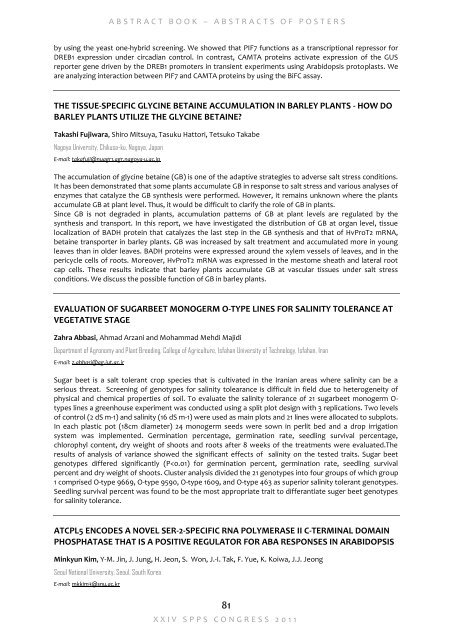1. Front Cover.cdr - CORE
1. Front Cover.cdr - CORE
1. Front Cover.cdr - CORE
Create successful ePaper yourself
Turn your PDF publications into a flip-book with our unique Google optimized e-Paper software.
A B S T R A C T B O O K – A B S T R A C T S O F P O S T E R S<br />
by using the yeast one-hybrid screening. We showed that PIF7 functions as a transcriptional repressor for<br />
DREB1 expression under circadian control. In contrast, CAMTA proteins activate expression of the GUS<br />
reporter gene driven by the DREB1 promoters in transient experiments using Arabidopsis protoplasts. We<br />
are analyzing interaction between PIF7 and CAMTA proteins by using the BiFC assay.<br />
THE TISSUE-SPECIFIC GLYCINE BETAINE ACCUMULATION IN BARLEY PLANTS - HOW DO<br />
BARLEY PLANTS UTILIZE THE GLYCINE BETAINE?<br />
Takashi Fujiwara, Shiro Mitsuya, Tasuku Hattori, Tetsuko Takabe<br />
Nagoya University, Chikusa-ku, Nagoya, Japan<br />
E-mail: takafuji@nuagr<strong>1.</strong>agr.nagoya-u.ac.jp<br />
The accumulation of glycine betaine (GB) is one of the adaptive strategies to adverse salt stress conditions.<br />
It has been demonstrated that some plants accumulate GB in response to salt stress and various analyses of<br />
enzymes that catalyze the GB synthesis were performed. However, it remains unknown where the plants<br />
accumulate GB at plant level. Thus, it would be difficult to clarify the role of GB in plants.<br />
Since GB is not degraded in plants, accumulation patterns of GB at plant levels are regulated by the<br />
synthesis and transport. In this report, we have investigated the distribution of GB at organ level, tissue<br />
localization of BADH protein that catalyzes the last step in the GB synthesis and that of HvProT2 mRNA,<br />
betaine transporter in barley plants. GB was increased by salt treatment and accumulated more in young<br />
leaves than in older leaves. BADH proteins were expressed around the xylem vessels of leaves, and in the<br />
pericycle cells of roots. Moreover, HvProT2 mRNA was expressed in the mestome sheath and lateral root<br />
cap cells. These results indicate that barley plants accumulate GB at vascular tissues under salt stress<br />
conditions. We discuss the possible function of GB in barley plants.<br />
EVALUATION OF SUGARBEET MONOGERM O-TYPE LINES FOR SALINITY TOLERANCE AT<br />
VEGETATIVE STAGE<br />
Zahra Abbasi, Ahmad Arzani and Mohammad Mehdi Majidi<br />
Department of Agronomy and Plant Breeding, College of Agriculture, Isfahan University of Technology, Isfahan, Iran<br />
E-mail: z.abbasi@ag.iut.ac.ir<br />
Sugar beet is a salt tolerant crop species that is cultivated in the Iranian areas where salinity can be a<br />
serious threat. Screening of genotypes for salinity tolearance is difficult in field due to heterogeneity of<br />
physical and chemical properties of soil. To evaluate the salinity tolerance of 21 sugarbeet monogerm Otypes<br />
lines a greenhouse experiment was conducted using a split plot design with 3 replications. Two levels<br />
of control (2 dS m-1) and salinity (16 dS m-1) were used as main plots and 21 lines were allocated to subplots.<br />
In each plastic pot (18cm diameter) 24 monogerm seeds were sown in perlit bed and a drop irrigation<br />
system was implemented. Germination percentage, germination rate, seedling survival percentage,<br />
chlorophyl content, dry weight of shoots and roots after 8 weeks of the treatments were evaluated.The<br />
results of analysis of variance showed the significant effects of salinity on the tested traits. Sugar beet<br />
genotypes differed significantly (P


